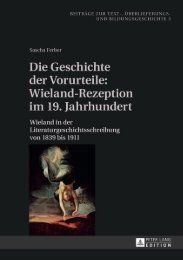Extract (PDF) - Peter Lang
Extract (PDF) - Peter Lang
Extract (PDF) - Peter Lang
Create successful ePaper yourself
Turn your PDF publications into a flip-book with our unique Google optimized e-Paper software.
6 Fernanda Peñaloza<br />
the English made a few attempts to colonise Patagonia, but the region<br />
remained virtually devoid of European settlements for over 300 years. The<br />
most important explorations to Patagonia in the sixteenth century were<br />
those of Pedro Sarmiento de Gamboa (1578) and Sir Francis Drake (1578).9<br />
From then on, interest in travelling around the region seems to have faded<br />
away until John Byron circumnavigated the globe once again (1740).10 Lord<br />
Byron is the main protagonist of <strong>Peter</strong> Hulme’s essay, which is the first one<br />
of this volume. Hulme focuses on Commodore Anson’s voyage round the<br />
world and the hardships the men on the Wager had to endure when the<br />
ship was wrecked off the eastern coast of Patagonia in May 1741. By historicising<br />
the meanings attached to two specific geographical spaces – islands<br />
and beaches – Hulme raises important questions about the dynamics of<br />
colonial power. Hulme’s reading of Byron’s self-representation as a man in<br />
a desperate situation shows that the discursive practices that emerged from<br />
this particular colonial encounter cannot be reduced to an account of a<br />
binary opposition between the colonising subject and the colonised other.<br />
A few decades after the shipwreck of the Wager, the Jesuit Thomas<br />
Falkner (1774) explored the area while living for thirty years as a missionary<br />
in Argentina, and James Cook surveyed the Patagonian coastline (1775).11<br />
The interest in rare accounts of Patagonia appeared to have gone astray,<br />
until the nineteenth century when explorers, missionaries and adventurers<br />
9 Edward J. Goodman’s historical account of early explorers in Patagonia is still the most<br />
authoritative; see The Explorers of South America, New York: Macmillan, 1972.<br />
10 Byron reported in his own account that the Tehuelches “were all cloathed in Skins of<br />
wild Beasts of different kinds which they wore as Highlander wears his Plaid, many<br />
of these Skins were very curious & very large, as indeed they ought to be to cover<br />
these People who in size come the nearest to Giants” (57). In one of the versions<br />
of Byron’s journal, there is an illustration that shows an English sailor, who like<br />
Pigafetta’s account and the Conquistador of Gutiérrez’s map, can only reach the waist<br />
of a Patagonian woman holding a child and her husband standing beside her. There<br />
is controversy around the authorship of the journal of Byron’s circumnavigation as<br />
many versions of the journal were almost simultaneously published.<br />
11 According to Bruce Chatwin and Paul Theroux, Falkner’s book was in the library<br />
of the Beagle (34). For the most recent analysis of Thomas Falkner’s text see Ernesto<br />
Livon-Grosman (51–70).

















